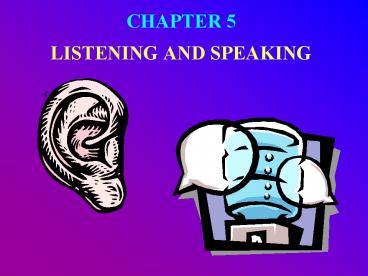LISTENING AND SPEAKING - PowerPoint PPT Presentation
1 / 31
Title:
LISTENING AND SPEAKING
Description:
Poetry and music. Draw the design. Creating a junk box. Advertising. Listening Activities ... Reader's theatre. Theatre acting. Types of Choral Speaking ... – PowerPoint PPT presentation
Number of Views:1831
Avg rating:3.0/5.0
Title: LISTENING AND SPEAKING
1
LISTENING AND SPEAKING
CHAPTER 5
2
Listening vs. Hearing
- Listeners speakers depend on each other for the
creation and exchange of meaningful information
3
Average Time Spent on Communication Activities
4
Six Steps in the Listening Process (Freshour
Bartholomew, 1989)
- Receiving
- Attending
- Understanding
- Analyzing
- Evaluating
- Reacting
5
Sample Listening List
6
Types of Listening (Miller, 2000)
- Discriminative
- Purposeful
- Creative
- Critical
- Appreciative
7
Integrating Listening into the Curriculum
- Listening and reading
- Listening and speaking
- Listening and writing
8
Suggestions for Teaching Listening in the
Classroom
- Set a purpose for listening
- Model good listening habits
- Make sure you have everyones attention before
speaking - Encourage students to listen to each other
- Encourage note taking
- Arrange your classroom for optimal listening
9
Approaches to Teaching Listening
- Whole-group
- Small-group
- Learning centers
10
Listening Activities
- Teacher questioning
- Singing songs and finger plays
- DL-TA
- Visualizing the story
- Listening centers
- Whose voice am I on the tape?
- Poetry and music
- Draw the design
- Creating a junk box
- Advertising
11
Listening Activities
- Listening/reading transfer lesson
- Teacher questioning
- Structured listening activity
- Think aloud strategy
12
Questioning Hierarchy
- Literal right there question
- Response found in material
- Inferential think and search
- Answer not directly stated and must be
discovered - Evaluative on my own
- Requires a judgment about what is heard or read
- Applied writer and me
- Remember facts, infer details, make judgments,
recall personal experiences, make connections
to what is heard or read
13
Think Aloud Strategy
- Read aloud a story
- Make predictions about what will happen next
- Describe a visual image you create from the story
- Make connections between the story and your
personal experiences and knowledge - Verbalize comprehension strategies
14
Listening Assessment
- 1. Standardized tests Durrell
ListeningReading Series - Stanford Achievement
- 2. Informal reading inventories
15
Speaking Goals for a Fourth Grade Classroom
- Speak clearly with proper pronunciation
enunciation - Speak expressively with feeling
- Speak effectively in different situations
- Use speaking to further learning
16
Importance of Oral Language Instruction
- Children with good oral language skills tend to
read more easily and become better readers than
other students. - Writing ability is enhanced through oral language
activities. - Speech facilitates thought.
17
Creating a Positive Environment for Speaking
- Develop a positive, receptive teacher attitude
- Make a variety of materials available
- Organize physical environment conducive to
language use
18
Speaking Activities
- Conversation/discussion
- Transactional literature discussion
- Brainstorming
- Interviewing
- Group projects
- Intellectual kits
- Dialogue improvisation and patterned conversation
- Show-and-tell sharing
19
Transactional Literature Discussions
- Get ready select book, skim contents, and make
predictions - Reading and stopping to think aloud
- Written response
- Discussion (using RQL2 strategy)
- Write
- Review
20
Principles of Brainstorming (Moffett Wagner,
1991)
- Select a problem or topic and react to it quickly
- Designate one person to record ideas
- Accept and record all ideas
- Build on other ideas
- Do not criticize other ideas
- Quantity of ideas is more important than quality
21
Sample Schematic Cluster Sound of Sunshine,
Sound of Rain
22
Instructions for Using an Intellectual Kit
23
Objectives for Using Drama in the Classroom
(McCaslin, 1996)
- To encourage creative and aesthetic development
- To improve critical thinking abilities
- To create a social and cooperative environment
- To improve communication skills
- To enhance self-knowledge
24
Dramatic Activities
- Dramatic play
- Movement or warm-up exercises
- Pantomime
- Choral speaking
- Storytelling
- Puppetry
- Readers theatre
- Theatre acting
25
Types of Choral Speaking
- Antiphonal or dialogue
- Line-a-group or line-a-child
- Refrain
- Unison
- Cumulative speaking
26
Storytelling Activities
- Talk boxes
- Story boxes
- Wordless books
- Liars goblet
- Serial stories
- Chalk or draw-along stories
- New versions and new endings
27
Speaking Assessment
28
Story-Telling Critique
29
Teaching Guidelines for Vocabulary Development
- Relate new terms to students prior knowledge and
background - Focus on using new terms rather than memorizing
definitions - Use activities that demand active student
involvement - Help students develop strategies for acquiring
new vocabulary - Build a conceptual base for the new word
30
Vocabulary Mini-Lessons
- Synonyms
- Antonyms
- Homonyms
- Multiple meanings
- Neologisms
- Portmanteaus
- Acronyms
31
Synonym Chart

